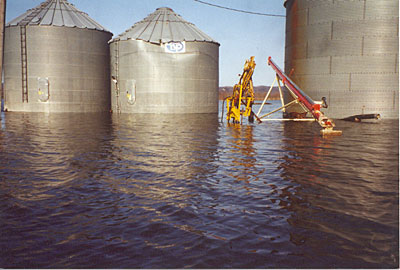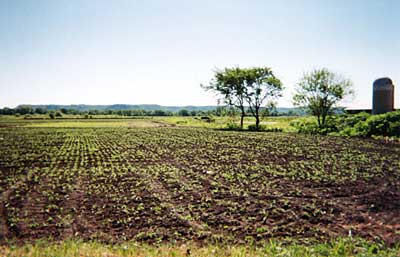Early wet weather dampening farmers' hopes for crops
By Laurel Druley, Minnesota Public Radio
July 6, 2001
Farmers typically like to see corn hip-high by the Fourth of July. But this was not a typical year. On July 1st, Minnesota corn height averaged 21 inches - a foot shorter than this time last year. Across the state, farmers are now trying to predict their crop yields.
JIM BARTON'S CORN is about shin high. And some of his soybeans are just emerging. Just a few months ago, Barton's farm was under almost three feet of Mississippi River floodwater. Today he's got two-thirds of his land planted with corn and soybeans. The rest was too wet to plant.
While he is struggling more than most, many farmers are behind because of a wet spring. The Minnesota Agricultural Statistic Service reports the number of acres planted statewide is down three percent compared to last year. And with late planting, many farmers, like Barton, are left guessing what their farm will yield come fall.
"Usually the earlier you plant it, the better off you are. If it freezes the early part of September, who knows what you'll get. That's why we quit planting beans, because you get the less yield. If it freezes the early part of September, it's not worth nothing," says Barton.
Most crops are behind. In the Red River Valley, sugar beet growth is two to three weeks late, and planting down 19,000 acres from last year.
Climatologist at the University of Minnesota, Mark Seeley, says the late planting will definitely hurt yields. Farmers haven't had a slow start like this since 1986. "We had a miraculous run in the 1990s. The timeliness of planting was just remarkable. We set all-time record yields in the state," according to Seeley.
Ironically farmers say their crops could use a little rain now, and consistent mild temperatures. Recent hot and humid conditions boosted crop growth, according to the Minnesota Agricultural Statistics Service. Corn shot up eight inches in one week in some places. But many central Minnesota crops in sandy soils are beginning to show signs of stress, because the soil doesn't hold moisture as well.
The early wet weather meant more weeds for many farmers, because the ground was too soft to till between rows. A majority of farmers chose to plant the Roundup Ready variety of soybeans so they could spray for weeds late in the season.
Many farmers, concerned about the late wet start to the season, switched from corn to soybeans, a more flexible crop requiring less nitrogen and heat. Minnesota farmers planted 7.2 million acres of soybeans this spring.
Last week, soybean prices jumped nearly five percent after the U.S. Department of Agriculture reported a record crop has been planted this year.
But its not all good news. Minnesota Department of Agriculture officials are warning about a soybean cyst infestation in most southern Minnesota counties, which could hurt yields. Even without that, Gyles Randall of the southern Research and Outreach Center in Waseca says the soybean yield projections in this part of the cornbelt are not as good as other areas.
"Our beans are on the small side now. If we don't get a later, longer growing season in the fall, we could be impacted by it. We'd have a significantly lower soybean yield," Randall says.
Randall says he's seen a major change for the better in the state's crops just in the last 10 days. "What one likes to see is a nice, uniform crop, field edge to field edge. That was a rare bird. It was a real ratty-looking crop and small and not good color. We still have a lot of drowned-out areas in fields, but the corn is much bigger, more uniform," according to Randall.
Still, Randall predicts a lot of spotty fields come harvest time, resulting in a lower average yield and tremendous variability within fields. He also predicts volatile commodity prices as the USDA releases more crop projections.
By Laurel Druley, Minnesota Public Radio
July 6, 2001
|
|
RealAudio |
Farmers typically like to see corn hip-high by the Fourth of July. But this was not a typical year. On July 1st, Minnesota corn height averaged 21 inches - a foot shorter than this time last year. Across the state, farmers are now trying to predict their crop yields.
| |
|
|
|
||
While he is struggling more than most, many farmers are behind because of a wet spring. The Minnesota Agricultural Statistic Service reports the number of acres planted statewide is down three percent compared to last year. And with late planting, many farmers, like Barton, are left guessing what their farm will yield come fall.
"Usually the earlier you plant it, the better off you are. If it freezes the early part of September, who knows what you'll get. That's why we quit planting beans, because you get the less yield. If it freezes the early part of September, it's not worth nothing," says Barton.
Most crops are behind. In the Red River Valley, sugar beet growth is two to three weeks late, and planting down 19,000 acres from last year.
Climatologist at the University of Minnesota, Mark Seeley, says the late planting will definitely hurt yields. Farmers haven't had a slow start like this since 1986. "We had a miraculous run in the 1990s. The timeliness of planting was just remarkable. We set all-time record yields in the state," according to Seeley.
Ironically farmers say their crops could use a little rain now, and consistent mild temperatures. Recent hot and humid conditions boosted crop growth, according to the Minnesota Agricultural Statistics Service. Corn shot up eight inches in one week in some places. But many central Minnesota crops in sandy soils are beginning to show signs of stress, because the soil doesn't hold moisture as well.
The early wet weather meant more weeds for many farmers, because the ground was too soft to till between rows. A majority of farmers chose to plant the Roundup Ready variety of soybeans so they could spray for weeds late in the season.
Many farmers, concerned about the late wet start to the season, switched from corn to soybeans, a more flexible crop requiring less nitrogen and heat. Minnesota farmers planted 7.2 million acres of soybeans this spring.
| |
|
|
|
||
"Our beans are on the small side now. If we don't get a later, longer growing season in the fall, we could be impacted by it. We'd have a significantly lower soybean yield," Randall says.
Randall says he's seen a major change for the better in the state's crops just in the last 10 days. "What one likes to see is a nice, uniform crop, field edge to field edge. That was a rare bird. It was a real ratty-looking crop and small and not good color. We still have a lot of drowned-out areas in fields, but the corn is much bigger, more uniform," according to Randall.
Still, Randall predicts a lot of spotty fields come harvest time, resulting in a lower average yield and tremendous variability within fields. He also predicts volatile commodity prices as the USDA releases more crop projections.


